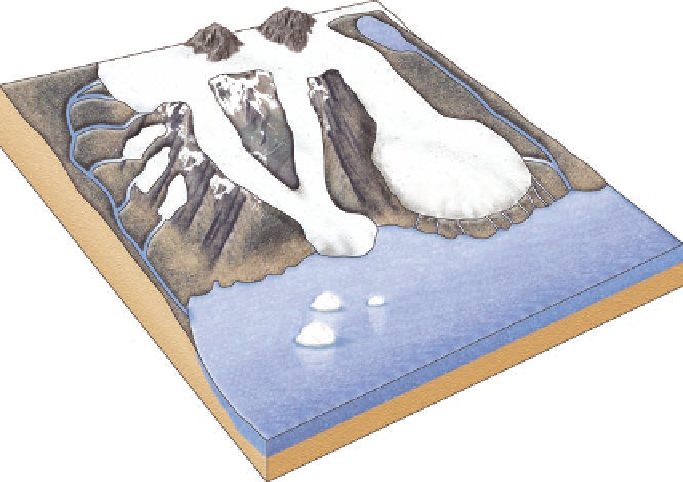Geoscience Reference
In-Depth Information
Washington
950 glaciers
160 sq. mi.
Figure 17.9 Alpine glaciers in the
Pacific Northwest and Alaska.
Most glaciers in the continental
United States are relatively small, as
indicated by the total area covered
in each state. The largest and most
impressive glaciers are in Alaska.
Montana
200 glaciers
16 sq. mi.
Oregon
60 glaciers
8 sq. mi.
Idaho
20 glaciers
<1 sq. mi.
Wyoming
100 glaciers
19 sq. mi.
Nevada
5 glaciers
<1 sq. mi.
Colorado
25 glaciers
<1 sq. mi.
Utah
1 glacier
<1 sq. mi.
California
290 glaciers
19 sq. mi.
Arctic Ocean
Alaska
Thousands
of glaciers
29,000 sq. mi.
Pacific
Ocean
0
100
200 km
0
100
200 mi
Pacific
Ocean
Nunataks
Meltwater lake
Ice cap or
ice field
Piedmont
glacier
Meltwater stream
Cirque
glaciers
Ocean
Tidewater
glacier
Valley
glacier
Icebergs calved
from glacier
(b)
(a)
Figure 17.10 Valley glaciers.
(a) Valley glaciers frequently originate at ice fields and ice caps and flow down terrain initially carved by
streams. They become piedmont glaciers if they expand beyond the valley front. (b) Tidewater glaciers occur where glacier ice meets the
sea. In these situations, such as seen here at the terminus of the Hubbard glacier in Alaska, ice calves off the front of the glacier and falls
into the water to form icebergs. Note the cruise ship in front of the glacier for scale.
























































































































































